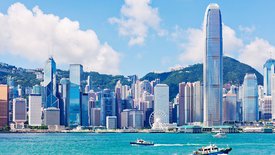How Hong Kong Leave Entitlements Fare in Asia for Standard Office Workers: A Comparison

‘All work and no play makes Jack a dull boy’ – a common saying known by many meant to describe how without time off from work, a person becomes both bored and stressed. And this is very true in every sense of the word. Research has shown that workers that don’t take vacation time have a higher likelihood of suffering from health issues. It is for this very reason that a majority of employed workers across the globe are entitled to some form of leave.
In this article, we will explore the types of leave entitlements Hong Kong offers to its citizens and workers and how it fares against other regions across Asia.
Annual Leave in Hong Kong
According to Hong Kong labour laws, annual leave entitlement for an employee is determined by their years of continuous service for a company. For the first two years, an employee is allowed to take at least 7 days of paid annual leave per year. Afterward with each progressive year, the number of leave days is increased by one until 9 years of service where the minimum stays at 14 days.
Annual Leave in Singapore
When it comes to annual leave in Singapore, it is almost an exact replica of Hong Kong’s system. The minimum is 7 days during the first year of employment and increases gradually one by one until 14 days. The only difference is that the first increase starts right after the first year meaning it reaches its top at 8 years of service instead.
Annual Leave in Japan
Annual leave in Japan is designed to reward those that stay with a company longer. This coincides with the country’s high regard for company loyalty. Under Japanese labour laws, once a full-time employee completes six months of employment they are entitled to 10 days of leave. Then for the next two years, similar to Hong Kong employment laws, each subsequent year of continuous work earns workers an additional day of leave. However, after reaching 3.5 years, the increment then increases to two days and topping off at 20 days once reaching 6.5 years of employment.
Annual Leave in Korea
For arguably the best entitlements in terms of annual leave, Korea is the place to be. Workers in the country start out with a minimum of 15 days of annual leave after their first year with a company. This remains the same until 3 years of employment have been completed where workers receive an additional day. This progresses incrementally with one day being added for every two years until it reaches 25 days at 22 years of continuous employment with a company.
Statutory Holidays in Hong Kong
Workers in Hong Kong work hard and long. In fact, as shown in one of our previous articles, “How Hong Kong's Working Hours Stack Up In Asia” , Hong Kong employees have the longest working week out of 71 surveyed cities around the world. To offset these long hours though, those working in Hong Kong have relatively more holidays.
Officially, Hong Kong has 12 statutory holidays. However, they also enjoy an additional 5 general holidays for a total of 17 days off a year. When compared to other countries in Asia, Hong Kong fares slightly better than most. Japan has 16 holidays per annum while Singapore has only 11. The few countries that do have more than Hong Kong include the Philippines with 18 and Cambodia with a whopping 22.
Paid Sick Leave, Compassionate Leave, and Other Types in Hong Kong
Paid sick leave in Hong Kong is handled a bit complicatedly. An employee can start accumulating paid sick days after entering a continuous contract. For the first 12 months, an employee receives two days of sick leave per month. Afterward, it becomes four days per month. A maximum of 120 days can be accumulated throughout the whole employment period. These 120 days are divided into two categories, 36 in Category 1 and 84 in Category 2. The days in the first category is usable upon providing a medical certificate issued by a registered medical practitioner, Chinese medical practitioner or registered dentist. Those in category 2 are only usable when the employee has exceeded his days in category 1 and if asked must produce to their employer a medical certificate issued by a medical practitioner that has been attending the employee as a patient in a hospital.
Previously, in one of our other articles that discussed leave entitlement in Hong Kong, we spoke on the topic of “Hong Kong Maternity Leave”. In it, we mentioned that compared to international laws on maternity and paternity leave policies, Hong Kong is still far behind. This is true in the case of compassionate leave as well.
Compassionate leave is defined as paid days off for workers when a member of their immediate family or household dies or develops a life-threatening illness or injury. Officially, there is no law that mandates a company to provide to its employees compassionate leave in Hong Kong. This is different from say mainland China, where workers are allowed one to three days of paid leave when the death of a parent, spouse or child occurs. For Shanghai, even parents-in-law are included.
When looking at the above, one would think that Hong Kong isn’t exactly leading the charge as a trailblazer for leave entitlement for its workers. However, one must recognize that these minimum requirements are not representative of the actual entitlements Hong Kong workers receive. Many Hong Kong companies offer their employees just as many paid leave days as their foreign counterparts in Asia and the rest of the world. In the end, company benefits vary from each other and to fully grasp one’s entitlements, employees need to check for themselves.





